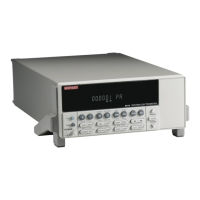4-10 Amps Measurements
In practice however, every ammeter has a voltage burden. If the voltage burden (V
B
) is 1mV,
the current will be measured as follows:
The 1mV voltage burden caused a 20% measurement error. Percent error in a measured read-
ing (I
M
) due to voltage burden can be calculated as follows:
The voltage burden of Model 6514 depends on the selected range (see specifications). Voltage
burden may be reduced by performing the offset correction procedure in Section 19.
Noise
Noise can seriously affect sensitive current measurements. The following paragraphs discuss
how source resistance and input capacitance affect noise performance.
Source resistance
The source resistance of the DUT will affect the noise performance of current measurements.
As the source resistance is reduced, the noise gain of the ammeter will increase, as we will now
discuss.
Figure 4-5 shows a simplified model of the feedback ammeter. R
S
and C
S
represents the
source resistance and source capacitance, V
S
is the source voltage, and V
NOISE
is the noise volt-
age. Finally, R
F
and C
F
are the feedback resistance and capacitance respectively.
The source noise gain of the circuit can be given by the following equation:
Note that as R
S
decreases in value, the output noise increases. For example, when R
F
= R
S
,
the input noise is multiplied by a factor of two. Since decreasing the source resistance can have
a detrimental effect on noise performance, there are usually minimum recommended source
resistance values based on measurement range. Table 4-2 summarizes minimum recommended
I
M
V
S
V
B
–
R
S
--------------------
5mV 1mV–
5kΩ
------------------------------- 0.8µA== =
I
M
%error
100%
V
S
/V
B
()
---------------------=
Source
R
s
V
s
Meter
I
M
=
R
S
V
S
- V
B
I
V
B
(Voltage
Burden)
+
-
+
-
Figure 4-4
Voltage burden
considerations
Output V
NOISE
Input V
NOISE
1 R
F
/R
S
+()=

